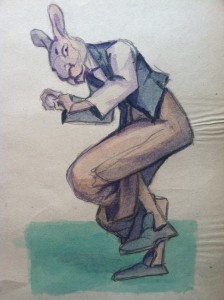
Once upon a time, in the Willard-Hay neighborhood of North Minneapolis, there were grand and beautiful mansions owned by the captains of finance and industry. These mansions, stately and proud, sat upon a hill overlooking the more modest, yet still impressive two-story homes.
Once upon a time, the people who lived in these homes felt that they had a duty to the artists of the world, and became patrons. They augmented an artist’s WPA commission, or teaching job, by purchasing numerous paintings and etchings, sketches and scribbles, or hiring the artists to decorate the home in any number of inventive ways, from designing a bar fit for a four-star hotel or designing a bas relief for the basement walls. If they grew close to the artists, then probably they hosted parties and fed them at grand dinners.
Times change, as they always do. The industries that supported these highbrows became antiquated or simply went out of business. Some thrive to this day, but the neighborhood has ceased to become attractive to the very rich. These towering homes are falling apart, the plaster on their ceilings tearing apart, the concrete crumbling, the glaze on the windows falling away to allow cold drafts to shoot across empty rooms.
As for the artists, they have fallen into obscurity, their work vanishing into the dim memories of the old, leaving the children gaping at their parents’ and grandparents’ collections as they wonder to themselves, “Who drew these strange rabbit people?”
 This weekend’s Star-Tribune revealed twenty-one different estate sales. I hit one on Thursday, visiting dignitary Mike Haeg and I tried our luck at three on Friday, and ESC Special Guest Stars Barry Kryshka and Stephanie Molstad went with us to three on Saturday, to little avail. But there was one sale, that Janice and I first saw on Friday evening, again on Saturday, and then I went to alone on Sunday, that proved to be the strangest, most intriguing sale I’ve visited in many a moon and the one we’ll examine here. Behold, the magical mansion of tornado alley.
This weekend’s Star-Tribune revealed twenty-one different estate sales. I hit one on Thursday, visiting dignitary Mike Haeg and I tried our luck at three on Friday, and ESC Special Guest Stars Barry Kryshka and Stephanie Molstad went with us to three on Saturday, to little avail. But there was one sale, that Janice and I first saw on Friday evening, again on Saturday, and then I went to alone on Sunday, that proved to be the strangest, most intriguing sale I’ve visited in many a moon and the one we’ll examine here. Behold, the magical mansion of tornado alley.
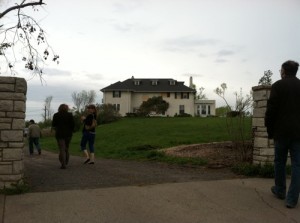 Honestly, I did not know this neighborhood existed in Minneapolis. Just off the Wirth public golf course, tucked back behind rows of beautiful homes in a rough neighborhood (as evidenced by the many, many signs reading “We Watch, We Call!”, as in, call the police if they see signs of trouble), were three stately homes, mansions really, atop a hill. The palaces of the wealthy from the jazz age, reduced now to properties only the most quixotic would dream of owning.
Honestly, I did not know this neighborhood existed in Minneapolis. Just off the Wirth public golf course, tucked back behind rows of beautiful homes in a rough neighborhood (as evidenced by the many, many signs reading “We Watch, We Call!”, as in, call the police if they see signs of trouble), were three stately homes, mansions really, atop a hill. The palaces of the wealthy from the jazz age, reduced now to properties only the most quixotic would dream of owning.
 Frankly, it reminded me of Detroit. Detroit, as you may or may not know, has over half its homes abandoned, including homes as big as these. To make our situation here even more perplexing, a good number of windows were boarded up, the lawn was unmowed, clogged with weeds and dotted with yellow dandelions, and the shrubbery was unkempt.
Frankly, it reminded me of Detroit. Detroit, as you may or may not know, has over half its homes abandoned, including homes as big as these. To make our situation here even more perplexing, a good number of windows were boarded up, the lawn was unmowed, clogged with weeds and dotted with yellow dandelions, and the shrubbery was unkempt.
Then I remembered: this was the neighborhood that was ravaged by a tornado last spring. You could see the large round circles in the lawn, big as a full size pickup, where giant trees once stood. Behind the home, by Bassett Creek, tons of broken and twisted trees were on their side, and those that stood had big, busted limbs. This explained the broken windows as well.
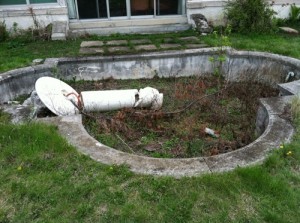 But the home clearly had fallen on hard times prior to this–as I wandered around the place I saw an old fountain, the Lorax fountain I called it (and not after that fucking movie, thank you very much), which had seen better days. Many hundreds of days ago, I’m guessing.
But the home clearly had fallen on hard times prior to this–as I wandered around the place I saw an old fountain, the Lorax fountain I called it (and not after that fucking movie, thank you very much), which had seen better days. Many hundreds of days ago, I’m guessing.
To get inside, the estate sale company had you wander through the two car garage, past a dingy mud room (where they had set up their valuables’ case–two glass cases filled with jewelry and what-not.) Past this, you were in the basement, with its green walls, circus-like bar, and giant WPA-style bas relief.
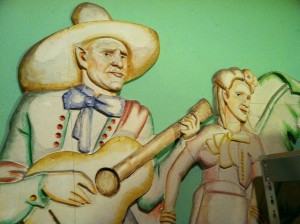 Wait, what? That’s right, a giant bas relief. These were not life-sized, they were bigger than life, a good eight feet tall in a basement with ten foot tall ceilings. Oddly enough, and this was most surprising, the room, despite having broken walls, despite having uneven floors, despite feeling damp, did not, in fact, reek of mildew.
Wait, what? That’s right, a giant bas relief. These were not life-sized, they were bigger than life, a good eight feet tall in a basement with ten foot tall ceilings. Oddly enough, and this was most surprising, the room, despite having broken walls, despite having uneven floors, despite feeling damp, did not, in fact, reek of mildew.
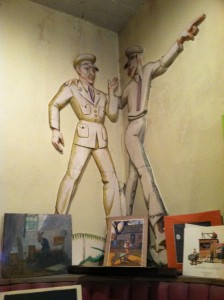 Like many basements, this one was like a warren, with a large central room, then the bar, and then behind the plastered rooms were the hallways and rooms with exposed beams, concrete floors, and wood shelves for canning or storing bodies and what-not. With the bar, the art, the large rooms, I could imagine a real hootenanny down there in the 20s and 30s, a bunch of artists, probably crashing out in one of the many rooms, downstairs for a real bender. No doubt the hosts had the finest liquors, and judging from the books upstairs, I bet the conversations were crackling as well.
Like many basements, this one was like a warren, with a large central room, then the bar, and then behind the plastered rooms were the hallways and rooms with exposed beams, concrete floors, and wood shelves for canning or storing bodies and what-not. With the bar, the art, the large rooms, I could imagine a real hootenanny down there in the 20s and 30s, a bunch of artists, probably crashing out in one of the many rooms, downstairs for a real bender. No doubt the hosts had the finest liquors, and judging from the books upstairs, I bet the conversations were crackling as well.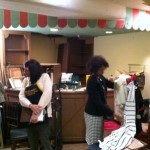
It was beneath the pair of soldiers pointing their way to the liquor that I first discovered the rabbits. There were a stack of these weird watercolors, oils and sketches. As you know by now, amateur art abounds at the estate sale–most of it is pure garbage. Sometimes you’ll find something moderately interesting, but I choose to just snap a photo and move on.
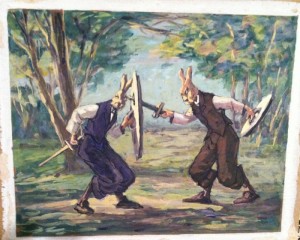 At first, I thought these rabbits were in that vein. To be honest, all this talk about basement soirees is purely hindsight. I didn’t know anything about the people who lived here, other than they had a crazy basement and at one time were rich. Maybe they were still rich, I didn’t know.
At first, I thought these rabbits were in that vein. To be honest, all this talk about basement soirees is purely hindsight. I didn’t know anything about the people who lived here, other than they had a crazy basement and at one time were rich. Maybe they were still rich, I didn’t know.
 But the rabbits! The more I dug through these (and at the time I was the only one), they began to speak to me. Not literally, but in the way that a piece of fascinating art speaks to your, I don’t know, your soul perhaps. Strange rabbits, dressed in tweed, dueling with wooden swords (above, left.)
But the rabbits! The more I dug through these (and at the time I was the only one), they began to speak to me. Not literally, but in the way that a piece of fascinating art speaks to your, I don’t know, your soul perhaps. Strange rabbits, dressed in tweed, dueling with wooden swords (above, left.)
But the one that really reached out and grabbed my attention was the welcoming rabbit (right.) A gentleman farmer, pausing for just a moment from muscling his wheelbarrow to a pile of carrots, say, and with a friendly grin, inviting you inside with a jerk of his thumb. The autumnal colors, the warmth of the home and the obvious pleasure of the rabbit man at your visit, was so appealing, I knew it was mine no matter the price. I was transfixed, and must’ve stared at it for five minutes, going over each roof shingle, the late-afternoon shadows, the pants hanging over the fence.
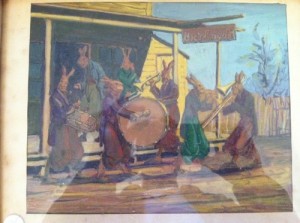 These were not altogether cheap–each one was going for $30 and up. I grabbed the Wheelbarrow Rabbit and the Dueling Rabbits and the Br’er Rabbit band, in a beat up frame and going for $90. I wasn’t sure I was going to get them, but something told me these wouldn’t last very long, and I was right.
These were not altogether cheap–each one was going for $30 and up. I grabbed the Wheelbarrow Rabbit and the Dueling Rabbits and the Br’er Rabbit band, in a beat up frame and going for $90. I wasn’t sure I was going to get them, but something told me these wouldn’t last very long, and I was right.
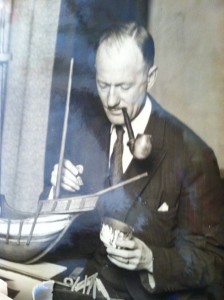 Upstairs there were more rabbits, and our artist was at last revealed. He signed some of his work, but even then it was hard to distinguish the name. This was Frederick W. Bock, born and raised in Wisconsin, then a young man in St. Paul, employed at one point by the Works Progress Administration. He was known as “The Rabbit Man”, if the framed article by the Dearborn (MI) Independent is to be believed.
Upstairs there were more rabbits, and our artist was at last revealed. He signed some of his work, but even then it was hard to distinguish the name. This was Frederick W. Bock, born and raised in Wisconsin, then a young man in St. Paul, employed at one point by the Works Progress Administration. He was known as “The Rabbit Man”, if the framed article by the Dearborn (MI) Independent is to be believed.
THE HUMOR OF THE RABBIT MAN
An Artist Who Has Transformed Br’er Rabbit Into a Living Character
by Grace Polk
His friends call him “The Rabbit Man.”
And when a man has drawn, or painted or etched, say a thousand rabbits, and has, tucked away in the corners of his brain, all ready to produce when the urge grips him, thousands more, he should be entitled to the name…
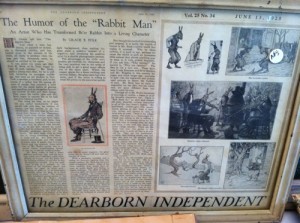 Unfortunately, this neat framed article, with everything you need to know about Mr. Bock, aka The Rabbit Man, was not for sale (neither was the photo.) He was apparently an odd duck, who perhaps didn’t articulate in a way that the writer of said piece felt was clear and understandable. “This being his idea, he might tell you rather incoherently if you should talk with him, his rabbits, of course, are not rabbits at all but rabbit men. Old men that he had seen along river towns of the Mississippi, darky types from farther south, rich and immensely important town aldermen, he drew with hairy faces, long ears, and flappy forepaws.” When asked, apparently by Ms. Polk, ‘why rabbits’, his answer we know in advance: ‘why not rabbits’?
Unfortunately, this neat framed article, with everything you need to know about Mr. Bock, aka The Rabbit Man, was not for sale (neither was the photo.) He was apparently an odd duck, who perhaps didn’t articulate in a way that the writer of said piece felt was clear and understandable. “This being his idea, he might tell you rather incoherently if you should talk with him, his rabbits, of course, are not rabbits at all but rabbit men. Old men that he had seen along river towns of the Mississippi, darky types from farther south, rich and immensely important town aldermen, he drew with hairy faces, long ears, and flappy forepaws.” When asked, apparently by Ms. Polk, ‘why rabbits’, his answer we know in advance: ‘why not rabbits’?
(And a side note: the Dearborn Independent was published by Henry Ford from 1919 to 1927, and was known for being blatantly anti-Semitic. At the time of this article, June 13, 1925, it was the second largest newspaper in the United States, mostly due to being promoted by Ford dealers.)
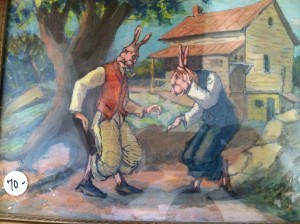 Upstairs, the rabbits were scattered over two tables in the living room. There were some badly framed watercolors, a beautiful etching (below, left), and a few sketches–probably twenty in all. These were laid out on a pair of large card tables, and you couldn’t help but stop and stare at them for ages–Janice and I ended up spending over two hours in this place.
Upstairs, the rabbits were scattered over two tables in the living room. There were some badly framed watercolors, a beautiful etching (below, left), and a few sketches–probably twenty in all. These were laid out on a pair of large card tables, and you couldn’t help but stop and stare at them for ages–Janice and I ended up spending over two hours in this place.
This was easily the most joyous estate sale I’ve ever had the pleasure to attend–everyone looking at the rabbits were just charmed, and everyone who grabbed one of Bock’s work would stop and ask to see another’s, and everyone would happily share their treasure.
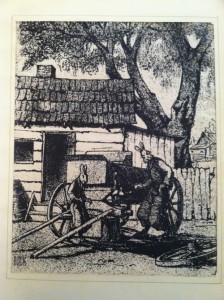
But it’s damned difficult to find out anything about Mr. Bock. An online search pointed me to a book, Minnesota Prints and Printmakers 1900-1945, by Robert L. Crump, which gives us a brief biography. Apparently, Frederick was born in 1876 and died in 1958. He found himself in 1900 working for a newspaper called The St. Paul Globe, then started a commercial art firm called Bock & Resler. According to Mr. Crump, Bock left St. Paul for New York to study at the National Academy of Design, as well as the Art Students League, which you would think he would do before becoming a commercial artist, but maybe not. In any case, he came back to St. Paul, found work in the WPA, taught at the Walker Art Center, and won a prize at the Minnesota State Fair.
Oddly enough, my research shows that you can buy that prize winning etching on eBay. I don’t know if Bock was a poor speller, but I’m amused by the back of said etching, which reads, in a childish scrawl, “Ribbin Winner at the State Fair.”
 Elated, and with as much art as I could afford, I was now able to wander the house, looking for other treasures. There was a lot of fun stuff here, especially if you were into antiques. I found a box of ties, and for the first time I didn’t buy every beautiful vintage tie–there must’ve been fifty of them. I found a set of three hard-bound Eros magazines from the early 60s, perhaps the dullest and most unerotic publication in the world (and, as it turns out, was only worth a bit more than the four bucks I paid for each of them.)
Elated, and with as much art as I could afford, I was now able to wander the house, looking for other treasures. There was a lot of fun stuff here, especially if you were into antiques. I found a box of ties, and for the first time I didn’t buy every beautiful vintage tie–there must’ve been fifty of them. I found a set of three hard-bound Eros magazines from the early 60s, perhaps the dullest and most unerotic publication in the world (and, as it turns out, was only worth a bit more than the four bucks I paid for each of them.)
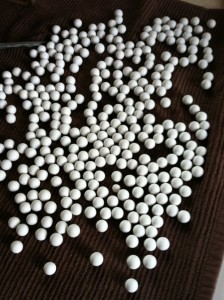 Janice was happy to have found a jar of ceramic pie weights, which, after cleaning and being left out to dry, appropriately looked very similar to petrified rabbit poop (left.)
Janice was happy to have found a jar of ceramic pie weights, which, after cleaning and being left out to dry, appropriately looked very similar to petrified rabbit poop (left.)
And so, with rabbit prints in hand, a dozen ties around my neck, Eros and Life magazines under my arm (and a weird novel by Caryl Chessman), I wandered the house and out on the grounds.
The mysteries continued: who lived here? The house was totally decrepit, and the upstairs was off limits, either because it was dangerous or because the homeowners were still in residence and wanted a place to live. And yet the kitchen did not seem as though it had been used in forever–it still had the original ceramic and iron stove.
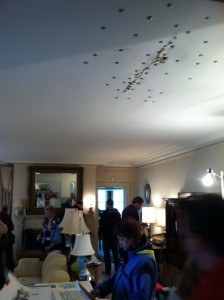 Clearly, the owners had fallen on hard times. The living room had a giant gash across the ceiling, held together by washers and screws. A good number of the upstairs windows were smashed out and boarded up. The basement ceiling was shored up by metal lifts, the carpet was old and torn, the white walls were scuffed and pock marked, and the grounds were a mess. Parts of the home were still beautiful, like this dining room (below, left), though the windows were drafty.
Clearly, the owners had fallen on hard times. The living room had a giant gash across the ceiling, held together by washers and screws. A good number of the upstairs windows were smashed out and boarded up. The basement ceiling was shored up by metal lifts, the carpet was old and torn, the white walls were scuffed and pock marked, and the grounds were a mess. Parts of the home were still beautiful, like this dining room (below, left), though the windows were drafty.
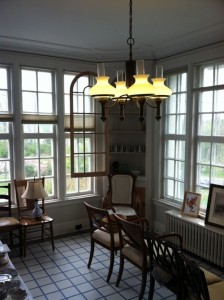 Certainly property values had collapsed since the neighborhood went to pot, which no doubt became even more acute during the recent crash. Then there was the tornado, which scraped across the city not a block away. Property records reveal the names, and those names were stung by Bernie Madoff. So there’s no luck here.
Certainly property values had collapsed since the neighborhood went to pot, which no doubt became even more acute during the recent crash. Then there was the tornado, which scraped across the city not a block away. Property records reveal the names, and those names were stung by Bernie Madoff. So there’s no luck here.
We asked the salespeople about the story, and no two were the same. “She got spooked by the tornado, and wants to sell everything!” one said. “I think she’s in a home,” another mentioned. One said she was dead, and I overheard a customer say, “ah, they don’t even live here anymore, they just store stuff.” A she, then a they. Hennepin County says they.
It was as though ghosts were wandering through the home, not unhappy ghosts, as I imagine this was once a festive place. I don’t believe in ghosts, of course, so perhaps these were just strong memories that waft off of the bas relief guitarist and his lady love. There were other artists featured in this sale, important enough to be mentioned in the online advertisement (G. Restler, Lowell Bobleter, Robert Connavale, E. L. Fields, Jerome Myers, and more–I don’t any of these), and I felt as though they probably knew the owners well (as opposed to their just owning the art.) But none stood out to me like Fred Bock, the rabbit man, and obviously none were as important, as the others didn’t warrant a framed newspaper article and photo.
On Friday, we walked out, stunned and happy, having purchased the wheelbarrow rabbit, the dueling rabbits, and the sketch of the rabbit at the top, who I like to think is about to uncork a fastball at the viewer (while dressed nattily), I couldn’t help but feel a twinge of sympathy for these once prominent folk. Unlike the cold, sad, thoroughly updated mansion from an earlier weekend, this one made me feel melancholy for the owners, who were, or are, no doubt also in the 1%.
I thought: what will happen to this house? Who would buy it today? For Christ’s sake, it would probably take a half million dollars just to renovate the thing, and with all due respect for the neighborhood, no one with that kind of change wants to live there.
On Saturday, I posed that question to Barry and Stephanie, wondering what you could possibly do with this place. You could raze the thing, but then what? “Maybe the city’ll take it,” Stephanie said. And do what with it? I wondered. “It would make a nice park,” she said.
Indeed it would. Maybe you could somehow save the bas relief and put it under a tree there, maybe have art fairs, any number of wonderful art projects–hell, a city art park, named after the former owners, or one of the artists. Like Frederick W. Bock.
Without question, it would be filled with rabbits…

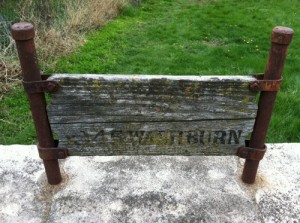
Peter, What an amazing find! I loved the commentary, and I could almost imagine being a visiting dignitary along for the hunt. I have been reading and enjoying the archived past editions. Love
Thanks, Jean! Hope that you will join us soon as our Special Guest Star! (Maybe this summer!)